标签:
Design篇
Notifying the User
DevBytes: Notifications in the Android L Developer Preview
The notification system allows users to keep informed about relevant and timely events in your app, such as new chat messages from a friend or a calendar event. Think of notifications as a news channel that alerts the user to important events as they happen or a log that chronicles events while the user is not paying attention—and one that is synced as appropriate across all their Android devices.
In Android 5.0, notifications receive important updates: structurally, visually, and functionally:
Note: Notification design in this version of Android is a significant departure from that of previous versions. For information about notification design in previous versions, see Notifications in Android 4.4 and lower.
This section goes over basic parts of a notification and how they can appear on different types of devices.
At a minimum, all notifications consist of a base layout, including:
Notifications created with Notification.Builder for previous platform versions look and work the same in Android 5.0, with only minor stylistic changes that the system handles for you. For more information about notifications on previous versions of Android, see Notifications in Android 4.4 and lower.

Base layout of a handheld notification (left) and the same notification on Wear (right), with a user photo and a notification icon
You can choose how much detail your app‘s notifications should provide. They can show the first few lines of a message or show a larger image preview. The additional information provides the user with more context, and—in some cases—may allow the user to read a message in its entirety. The user can pinch-zoom or perform a single-finger glide to toggle between compact and expanded layouts. For single-event notifications, Android provides three expanded layout templates (text, inbox, and image) for you to use in your application. The following images show you how single-event notifications look on handhelds (left) and wearables (right).
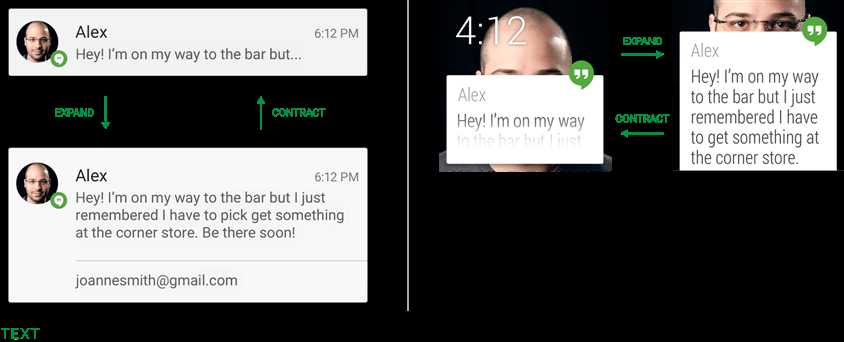
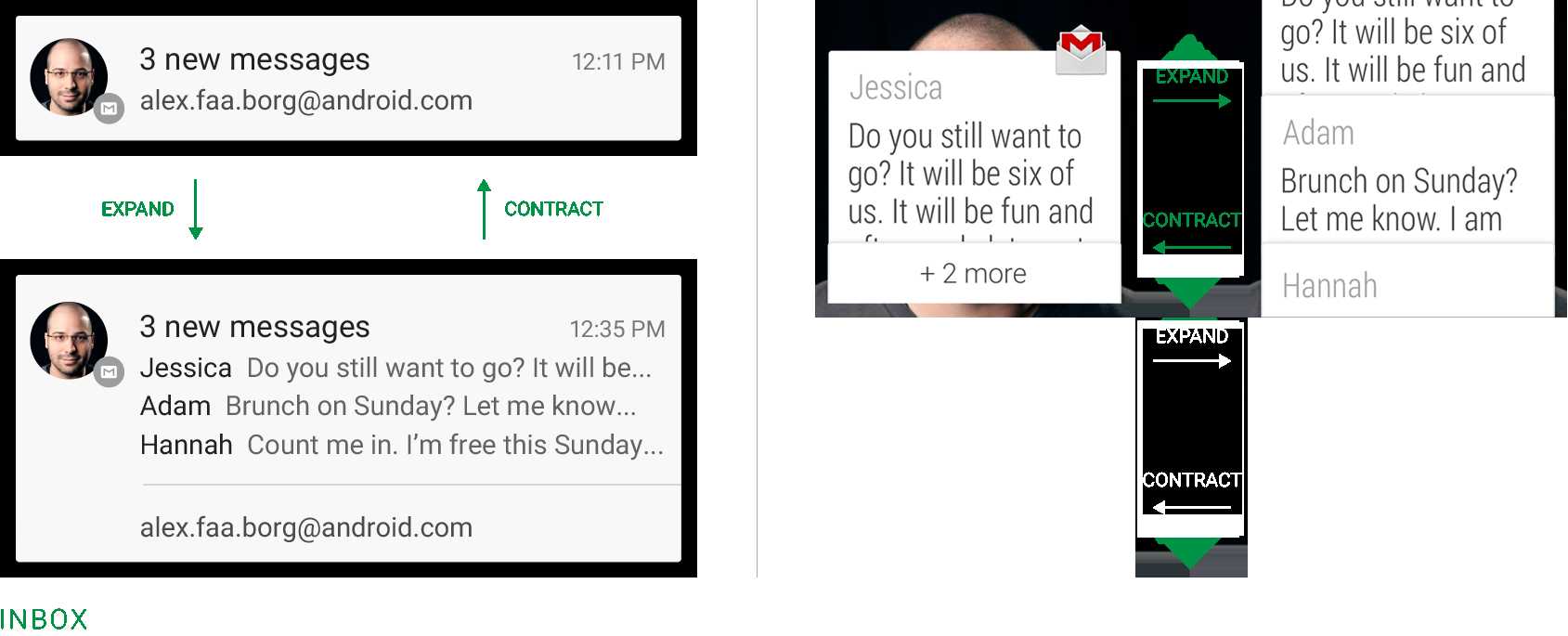
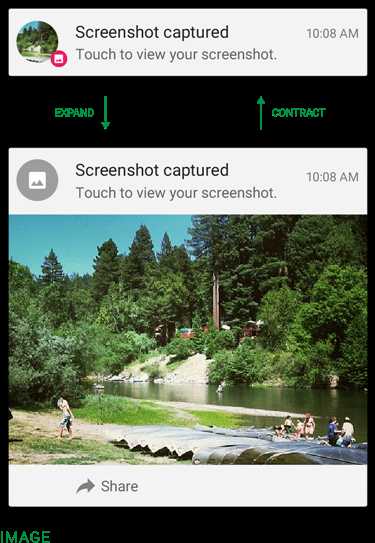
Android supports optional actions that are displayed at the bottom of the notification. With actions, users can handle the most common tasks for a particular notification from within the notification shade without having to open the originating application. This speeds up interaction and, in conjunction with swipe-to-dismiss, helps users focus on notifications that matter to them.

Be judicious with how many actions you include with a notification. The more actions you include, the more cognitive complexity you create. Limit yourself to the smallest number of actions possible by only including the most imminently important and meaningful actions.
Good candidates for actions on notifications are actions that:
Avoid actions that are:
You can specify a maximum of three actions, each consisting of an action icon and name. Adding actions to a simple base layout makes the notification expandable, even if the notification doesn‘t have an expanded layout. Since actions are only shown for expanded notifications and are otherwise hidden, make sure that any action a user can invoke from a notification is available from within the associated application, as well.
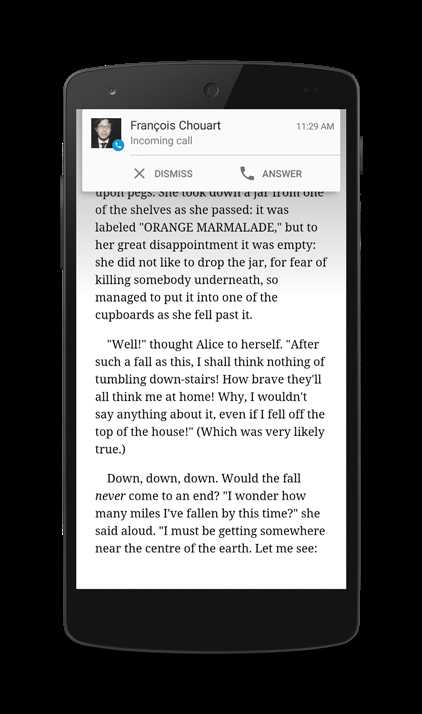
Example of a heads-up notification (incoming phone call, high priority) appearing on top of an immersive app
When a high-priority notification arrives (see right), it is presented to users for a short period of time with an expanded layout exposing possible actions.
After this period of time, the notification retreats to the notification shade. If a notification‘s priority is flagged as High, Max, or full-screen, it gets a heads-up notification.
Good examples of heads-up notifications
For notifications of items sent by another person (such as a message or status update), include that person‘s image usingsetLargeIcon(). Also attach information about the person to the notification‘s metadata (see EXTRA_PEOPLE).
Your notification‘s main icon is still shown, so the user can associate it with the icon visible in the status bar.
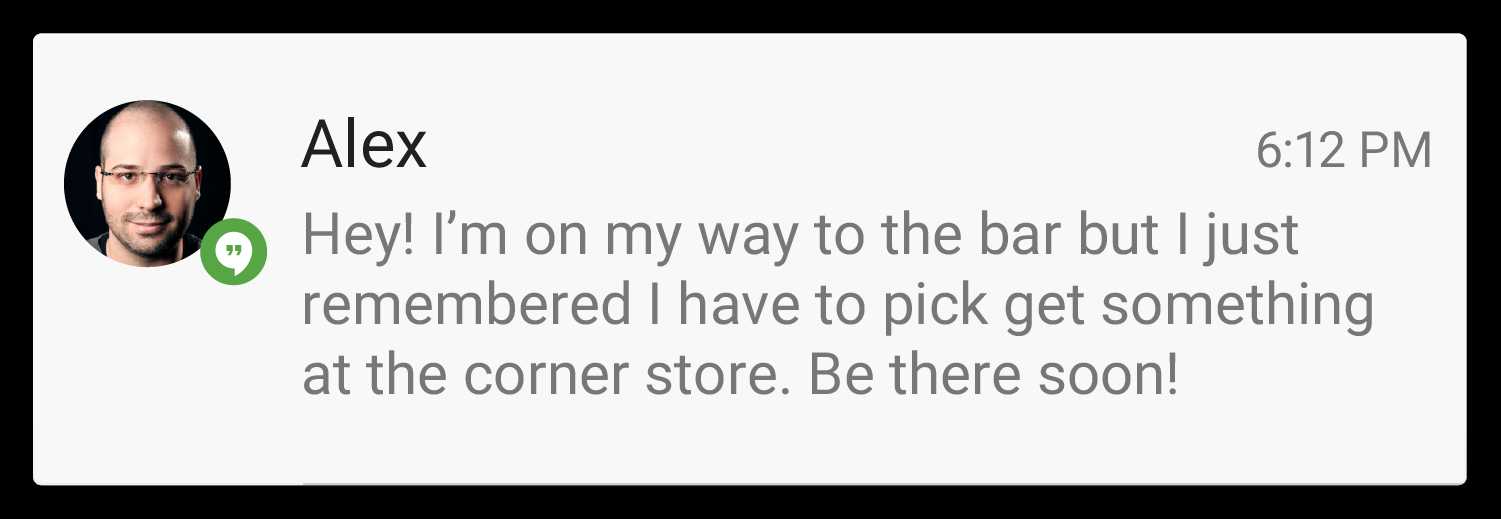
Notification that shows the person who triggered it and the content they sent.
When the user touches the body of a notification (outside of the action buttons), open your app to the place where the user can view and act upon the data referenced in the notification. In most cases, this will be the detailed view of a single data item such as a message, but it might also be a summary view if the notification is stacked. If your app takes the user anywhere below your app‘s top level, insert navigation into your app‘s back stack so that the user can press the system back button to return to the top level. For more information, see Navigation into Your App via Home Screen Widgets and Notifications in the Navigation design pattern.
Android supports a priority flag for notifications. This flag allows you to influence where your notification appears, relative to other notifications, and helps ensure that users always see their most important notifications first. You can choose from the following priority levels when posting a notification:
|
Priority |
Use |
|
|
Use for critical and urgent notifications that alert the user to a condition that is time-critical or needs to be resolved before they can continue with a particular task. |
|
|
Use primarily for important communication, such as message or chat events with content that is particularly interesting for the user. High-priority notifications trigger the heads-up notification display. |
|
|
Use for all notifications that don‘t fall into any of the other priorities described here. |
|
|
Use for notifications that you want the user to be informed about, but that are less urgent. Low-priority notifications tend to show up at the bottom of the list, which makes them a good choice for things like public or undirected social updates: The user has asked to be notified about them, but these notifications should never take precedence over urgent or direct communication. |
|
|
Use for contextual or background information such as weather information or contextual location information. Minimum-priority notifications do not appear in the status bar. The user discovers them on expanding the notification shade. |
DEFAULT, HIGH, and MAX are interruptive priority levels, and risk interrupting the user in mid-activity. To avoid annoying your app‘s users, reserve interruptive priority levels for notifications that:
Notifications set to LOW and MIN can still be valuable for the user: Many, if not most, notifications just don‘t need to command the user‘s immediate attention, or vibrate the user‘s wrist, yet contain information that the user will find valuable when they choose to look for notifications. Criteria for LOW and MIN priority notifications include:


If your notification falls into one of the predefined categories (see below), assign it accordingly. Aspects of the system UI such as the notification shade (or any other notification listener) may use this information to make ranking and filtering decisions.
|
Incoming call (voice or video) or similar synchronous communication request |
|
|
Incoming direct message (SMS, instant message, etc.) |
|
|
Asynchronous bulk message (email) |
|
|
Calendar event |
|
|
Promotion or advertisement |
|
|
Alarm or timer |
|
|
Progress of a long-running background operation |
|
|
Social network or sharing update |
|
|
Error in background operation or authentication status |
|
|
Media transport control for playback |
|
|
System or device status update. Reserved for system use. |
|
|
Indication of running background service |
|
|
A specific, timely recommendation for a single thing. For example, a news app might want to recommend a news story it believes the user will want to read next. |
|
|
Ongoing information about device or contextual status |
If a notification of a certain type is already pending when your app tries to send a new notification of the same type, combine them into a single summary notification for the app. Do not create a new object.
A summary notification builds a summary description and allows the user to understand how many notifications of a particular kind are pending.
Don‘t
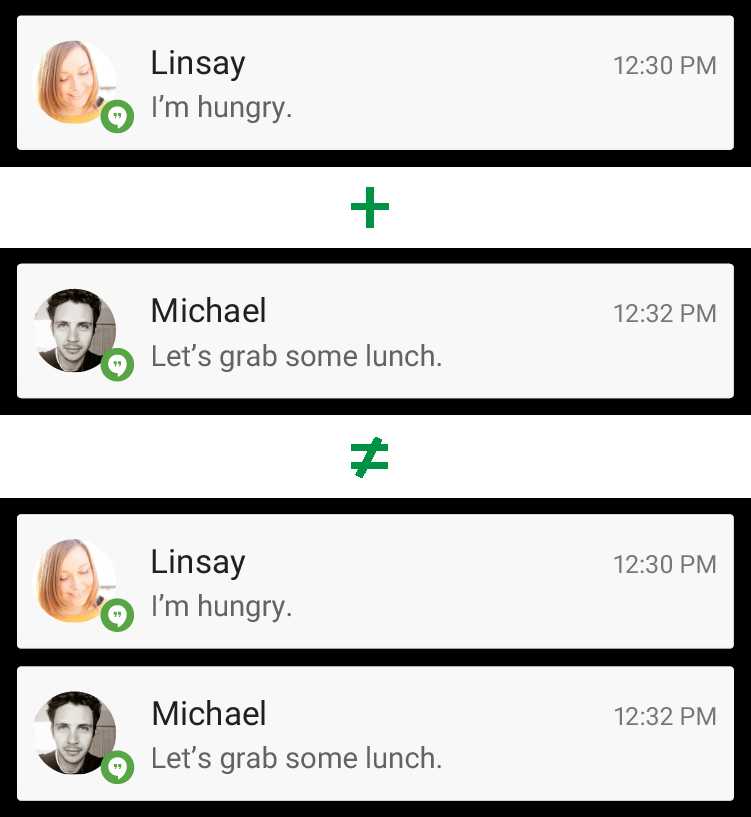
Do
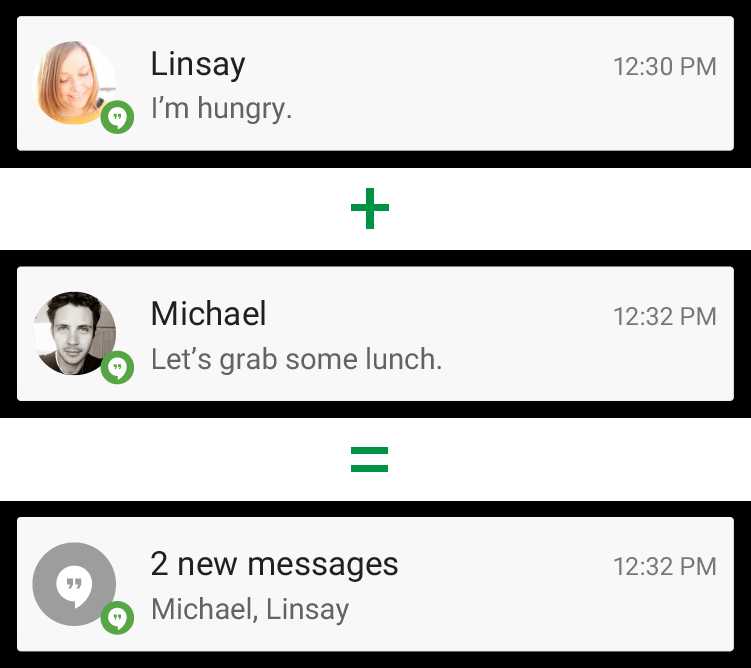
You can provide more detail about the individual notifications that make up a summary by using the expanded digest layout. This approach allows users to gain a better sense of which notifications are pending and if they are interesting enough to read in detail within the associated app.

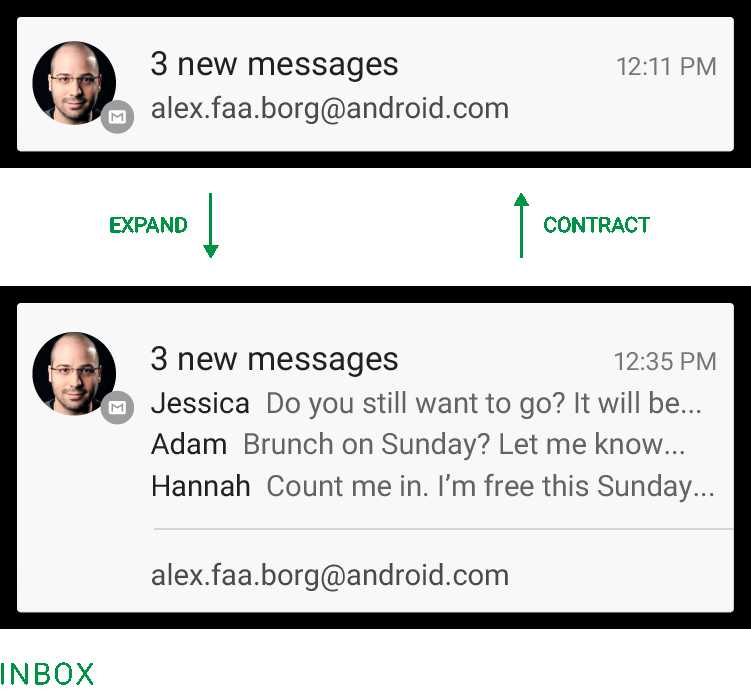
Users should always be in control of notifications. Allow the user to disable your app‘s notifications or change their alert properties, such as alert sound and whether to use vibration, by adding a notification settings item to your application settings.
By glancing at the notification area, the user should be able to discern what kinds of notifications are currently pending.
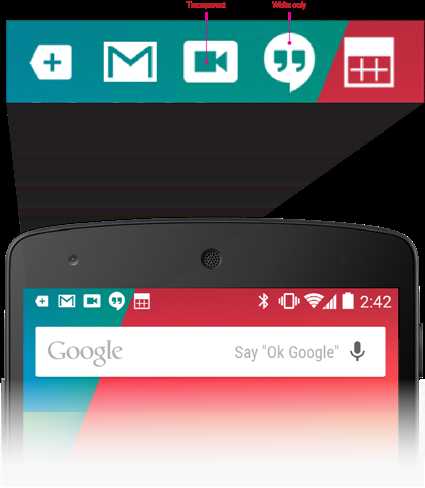
Do
Look at the notification icons Android apps already provide and create notification icons for your app that are sufficiently distinct in appearance.
Do
Use the proper notification icon style for small icons, and the Material Light action bar icon stylefor your action icons.
Do
Keep your icons visually simple, avoiding excessive detail that is hard to discern.
Don‘t
Place any additional alpha (dimming or fading) into your small icons and action icons; they can have anti-aliased edges, but because Android uses these icons as masks (that is, only the alpha channel is used), the image should generally be drawn at full opacity.
Don‘t
Use color to distinguish your app from others. Notification icons should only be a white-on-transparent background image.
Many Android devices contain a notification LED, which is used to keep the user informed about events while the screen is off. Notifications with a priority level of MAX, HIGH, or DEFAULT should cause the LED to glow, while those with lower priority (LOW and MIN) should not.
The user‘s control over notifications should extend to the LED. When you use DEFAULT_LIGHTS, the LED will glow white. Your notifications shouldn‘t use a different color unless the user has explicitly customized it.
To create an app that users love, it is important to design your notifications carefully. Notifications embody your app‘s voice, and contribute to your app‘s personality. Unwanted or unimportant notifications can annoy the user or make them resent how much attention the app wants from them, so use notifications judiciously.
To create an application that people enjoy using, it‘s important to recognize that the user‘s attention and focus is a resource that must be protected. While Android‘s notification system has been designed to minimize the impact of notifications on the user‘s attention, it is still important to be aware of the fact that notifications are interrupting the user‘s task flow. As you plan your notifications, ask yourself if they are important enough to warrant an interruption. If you are unsure, allow the user to opt into a notification using your apps notification settings, or adjust the notifications priority flag to LOW or MIN to avoid distracting the user while they are doing something else.
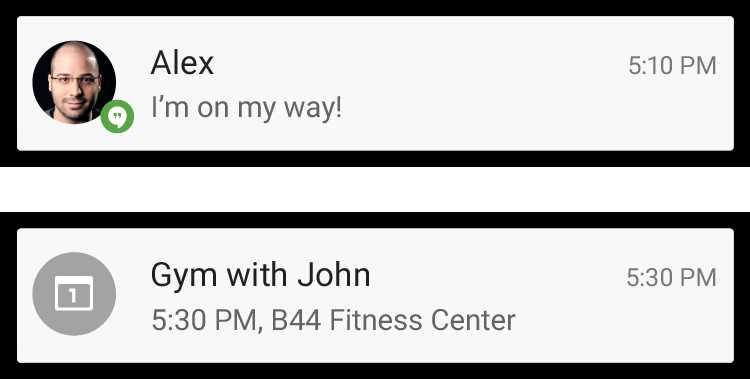
Examples of time-sensitive notification
While well-behaved apps generally only speak when spoken to, a few cases do merit an app‘s interrupting the user with an unprompted notification.
Use notifications primarily for time-sensitive events, especially if these synchronous events involve other people. For instance, an incoming chat is a real-time and synchronous form of communication: Another user actively waiting on your response. Calendar events are another good example of when to use a notification and grab the user‘s attention, because the event is imminent, and calendar events often involve other people.

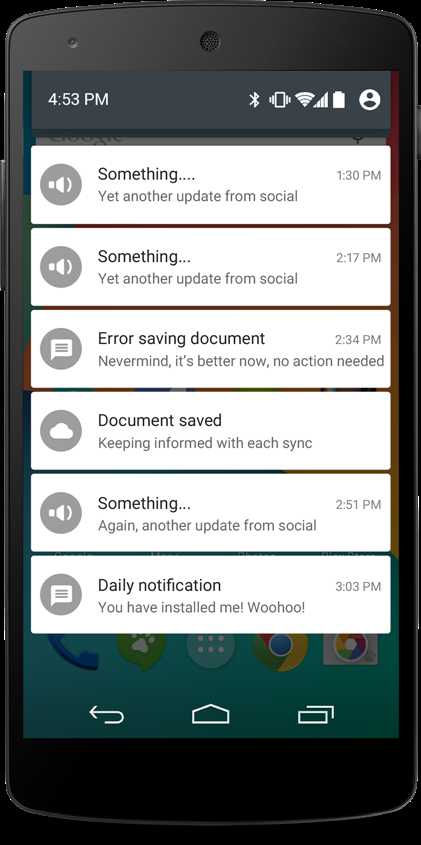
In many other cases, notifications aren‘t appropriate:
Notifications are indicated by icons in the status bar, and can be accessed by opening the notification drawer.
Touching a notification opens the associated app to detailed content that matches the notification. Swiping left or right on a notification removes it from the drawer.
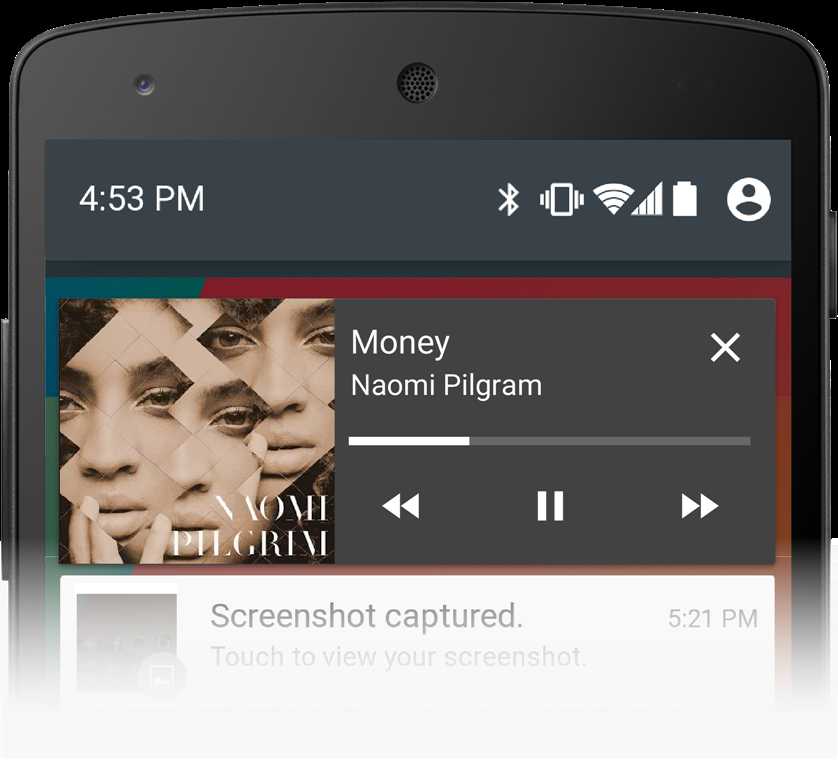
Ongoing notifications keep users informed about an ongoing process in the background. For example, music players announce the currently playing track in the notification system and continue to do so until the user stops the playback. Ongoing notifications can also show the user feedback for longer tasks like downloading a file, or encoding a video. A user cannot manually remove an ongoing notification from the notification drawer.
In Android 5.0, the lock screen doesn‘t show transport controls for the deprecated RemoteControlClient class. But it does show notifications, so each app‘s playback notification is now the primary way for users to control playback from a locked state. This behavior gives apps more control over which buttons to show, and in what way, while providing a consistent experience for the user whether or not the screen is locked.
Your app should not create a dialog or toast if it is not currently on screen. A dialog or toast should only be displayed as an immediate response to the user taking an action inside of your app. For further guidance on the use of dialogs and toasts, refer to Confirming & Acknowledging.
Notifications are news, and so are essentially shown in reverse-chronological order, with special consideration given to the app‘s stated notification priority.
Notifications are a key part of the lock screen, and are featured prominently every time the device display comes on. Space on the lock screen is tight, so it is more important than ever to identify the most urgent or relevant notifications. For this reason, Android has a more sophisticated sorting algorithm for notifications, taking into account:
EXTRA_PEOPLE, and, in particular, whether they are starred contacts.To best take advantage of this sorting, focus on the user experience you want to create, rather than aiming for any particular spot on the list.
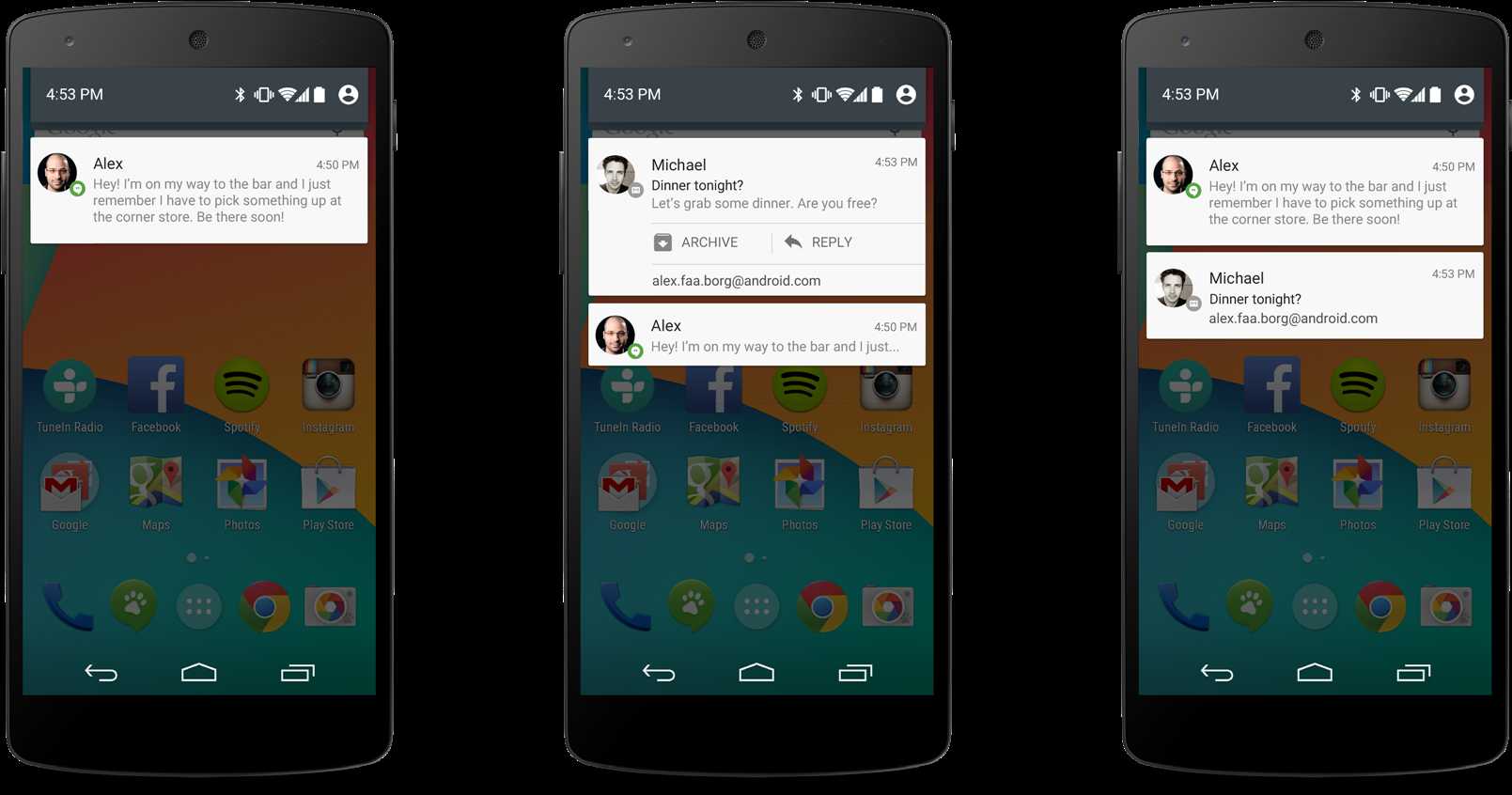
Because notifications are visible on the lock screen, user privacy is an especially important consideration. Notifications often contain sensitive information, and should not necessarily be visible to anyone who picks up the device and turns on the display.
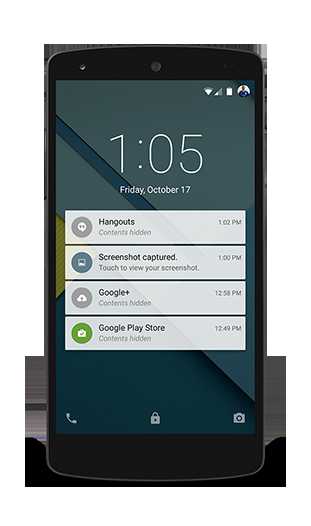
Notifications on the lock screen, with contents revealed after the user unlocks the device.
When setting up a secure lock screen, the user can choose to conceal sensitive details from the secure lock screen. In this case the System UI considers the notification‘s visibility level to figure out what can safely be shown.
To control the visibility level, callNotification.Builder.setVisibility(), and specify one of these values:
VISIBILITY_PUBLIC. Shows the notification‘s full content. This is the system default if visibility is left unspecified.VISIBILITY_PRIVATE. On the lock screen, shows basic information about the existence of this notification, including its icon and the name of the app that posted it. The rest of the notification‘s details are not displayed. A couple of good points to keep in mind are as follows:
Notification.publicVersion field.VISIBILITY_PRIVATE, but publicVersion could still contain useful information like "3 new messages" without any other identifying details.Notification.VISIBILITY_SECRET. Shows only the most minimal information, excluding even the notification‘s icon.Notifications and their actions are bridged over to Wear devices by default. Developers can control which notifications bridge from the phone to the watch, and vice-versa. Developers can also control which actions bridge, as well. If your app includes actions that can‘t be accomplished with a single tap, either hide these actions on your Wear notification or consider hooking them up to a Wear app, thus allowing the user to finish the action on their watch.
A connected device, such as a phone, can bridge notifications to a Wear device, so that the notifications are displayed there. Similarly, it can bridge actions, so that the user can act on the notifications right from the Wear device.
Bridge
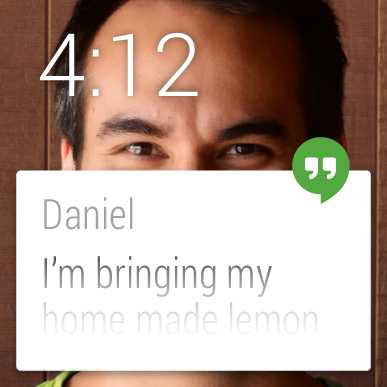
Don‘t bridge
There are some actions that you can perform only on Wear. These include the following:
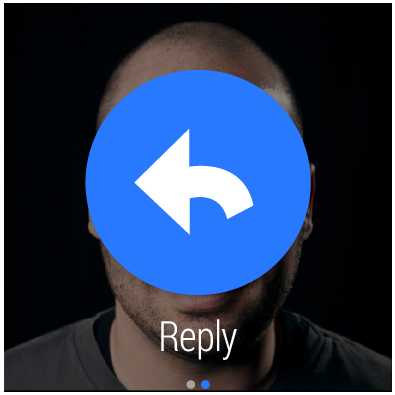
Android设计和开发系列第一篇:Notifications通知(Design)
标签:
原文地址:http://www.cnblogs.com/bvin/p/4303502.html